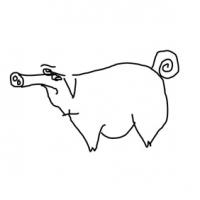Depends what your definition of "black" is. Considering he'd most likely of a middle-eastern or a Mediterranean of origin, he'd certainly have a kick-arse tan. Would that be "black", such as a fellow from Afrika? Who knows. Who cares.
I'm seeing too many religious topics in here, with little or no benefit.
Was Jesus black?
I just want some insight into the historical Jesus. What did he look like?
http://www.biblestudytools.com/kjv/revelation/passage.aspx?q=revelation+1:14-17
What things did he say that can be validated, etc?
The guy on the Shroud of Turin does not have facial fatures that appear very "African", if you ask me. Actually he looks like a guy I used to know in the 1970s...
Also, seeing how Caspar (one of the Three Magi) is explicitly pictured as "blackamoor" ("pictured" both in the literal and metaphorical sense), and I'm not aware of any such (non-20th century) depiction of Jesus, it seems kind of unlikely that you'll find a lot of Christians agreeing with the "black Jesus" theory. Although of course you never know... :-)
Also, seeing how Caspar (one of the Three Magi) is explicitly pictured as "blackamoor" ("pictured" both in the literal and metaphorical sense), and I'm not aware of any such (non-20th century) depiction of Jesus, it seems kind of unlikely that you'll find a lot of Christians agreeing with the "black Jesus" theory. Although of course you never know... :-)
[quote name='szecs' timestamp='1296892024' post='4769927']
Well there's a theory that Moses was black
do you have sources for this? I'm curious.
[/quote]
My source is teh Discovery Canal
The guy on the Shroud of Turin ...
is Leonardo's.
[size="2"]I like the Walrus best.
[quote name='samoth' timestamp='1296923340' post='4770025']
The guy on the Shroud of Turin ...
is Leonardo's.
[/quote]Hehehe, maybe, who knows :-)
However, Mr. Pacelli, who was the Church's CEO in the 1950s, would strongly disagree with you on that point. And, while controversial, in the light of the Reichskonkordat, which was another of Pacelli's achievements, this in my opinion somewhat odd interpretation of the 3rd commandment is probably the lesser evil. But hey, who am I to doubt Him who does not fail.
[quote name='owl' timestamp='1296924001' post='4770029']
[quote name='samoth' timestamp='1296923340' post='4770025']
The guy on the Shroud of Turin ...
is Leonardo's.
[/quote]Hehehe, maybe, who knows :-)
However, Mr. Pacelli, who was the Church's CEO in the 1950s, would strongly disagree with you on that point. And, while controversial, in the light of the Reichskonkordat, which was another of Pacelli's achievements, this in my opinion somewhat odd interpretation of the 3rd commandment is probably the lesser evil. But hey, who am I to doubt Him who does not fail.
[/quote]
Well, the truth is that whether we like it or not, relics were a very big business back then in medieval times and the renaissance (they still are today). It's speculated that the Shroud of Turin is one of the earliest photographies taken, and considering how brilliant (and refreshingly naughty) Leonardo was I wouldn't be surprised if he did it on request.
The properties of refraction were well known centuries before Christ and the chemicals required for photography were discovered around the lifetime of Leonardo so there are very good bases to believe he made it. There is an excellent documentary on this. I bet it's on youtube.
History of photography
[font=sans-serif][size=2][...] photography is the result of combining several technical discoveries. Long before the first photographs were made, Chinese philosopher Mo Di and Greek mathematicians Aristotle and Euclid described a pinhole camera in the 5th and 4th centuries BC.[sup][7][/sup][sup][8][/sup] In the 6th century CE, Byzantine mathematician Anthemius of Tralles used a type of camera obscura in his experiments,[sup][9][/sup] Ibn al-Haytham (Alhazen) (965–1040) studied the camera obscura and pinhole camera,[sup][8][/sup][sup][10][/sup] Albertus Magnus (1193–1280) discovered silver nitrate,[sup][11][/sup] and Georges Fabricius (1516–1571) discovered silver chloride.[sup][12][/sup] Daniele Barbaro described a diaphragm in 1568.[sup][13][/sup] Wilhelm Homberg described how light darkened some chemicals (photochemical effect) in 1694.[sup][14][/sup] The fiction book Giphantie, published in 1760, by French author Tiphaigne de la Roche, described what can be interpreted as photography.[sup][color=#0645AD][[color="#0645AD"]13[color=#0645AD]] [...][/sup][/font]
[/quote]
[size="2"]I like the Walrus best.
What did he say that can be validated? - I'm old but I'm not THAT old. Neither is anyone else here.
When starting a thread like this you need to provide your own opinions and reasons. Otherwise it's just a troll/flame bait thread and gets closed
When starting a thread like this you need to provide your own opinions and reasons. Otherwise it's just a troll/flame bait thread and gets closed
Dan Marchant - Business Development Consultant
www.obscure.co.uk
www.obscure.co.uk
This topic is closed to new replies.
Advertisement
Popular Topics
Advertisement









